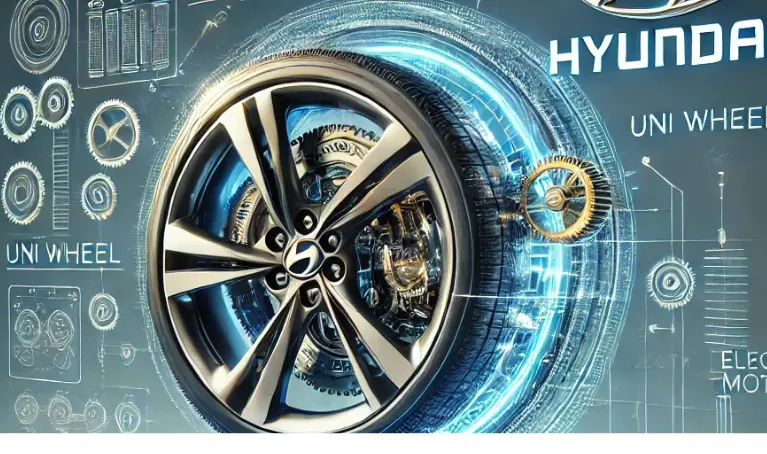The automotive industry is undergoing a revolutionary transformation, and Hyundai is at the forefront of this evolution. With the rise of Hyundai Design Uni Wheel Drive System, the brand is pushing the boundaries of innovation in electric vehicles (EVs) and autonomous driving. This system represents a significant leap in vehicle architecture, offering improved efficiency, safety, and design flexibility. In this article, we’ll explore what the Hyundai Design Uni Wheel Drive System is, its unique features, and why it is set to play a crucial role in the future of transportation.
Table of Contents
What is Uni Wheel?
The Uni Wheel refers to a highly integrated, single-wheel drive unit used in vehicles, primarily electric or autonomous, to provide independent propulsion. It combines multiple essential components, such as the electric motor, brakes, suspension, and steering mechanisms, all into a compact unit that controls one wheel independently.
Key Characteristics of the Uni Wheel:
- Modularity: Each wheel operates as an independent module, allowing for more freedom in vehicle design.
- Efficiency: Compact design increases energy efficiency and reduces the overall weight of the vehicle.
- Improved Handling: Provides precise control over each wheel’s power, steering, and braking, resulting in superior handling and stability.
What is Hyundai Design Uni Wheel Drive System?
Hyundai’s Uni Wheel Drive System is an advanced take on the Uni Wheel concept, designed to revolutionize vehicle mobility. This system incorporates Hyundai’s extensive expertise in electric vehicle technologies, leveraging a compact, all-in-one unit that integrates the motor, braking system, suspension, and steering mechanisms.
Hyundai’s design focuses on providing maximum efficiency, flexibility, and performance in modern vehicles, especially in EVs and autonomous platforms. The system allows each wheel to be independently controlled, offering advantages in energy savings, adaptability, and overall driving experience.
Why it Stands Out:
- Scalability: It can be applied to various vehicle types, from small urban transporters to larger passenger vehicles.
- Space Efficiency: By integrating all necessary components into each wheel unit, Hyundai’s Uni Wheel Drive System frees up significant space in the vehicle body for passengers or cargo.
- Future-Proofing: The design aligns with the future needs of autonomous driving systems, where independent wheel control is critical for safety and maneuverability.
Features of Hyundai Design Uni Wheel Drive System
The Hyundai Uni Wheel Drive System boasts several innovative features that make it a game-changer in the automotive world:
1. Integrated Drive, Brake, and Steering Systems
The system combines electric motors, braking units, and steering actuators into a compact unit around each wheel. This integration reduces the complexity of mechanical linkages traditionally required in vehicles.
2. Independent Control
Each wheel can be controlled separately, allowing for optimized torque distribution, better traction, and precise handling, especially in challenging driving conditions like icy or uneven surfaces.
3. All-in-One Design
By combining key vehicle functions into a single unit, the Uni Wheel Drive System enhances modularity, allowing manufacturers to adopt a “plug-and-play” approach when designing vehicles.
4. Energy Efficiency
The system reduces energy loss by eliminating the need for centralized power transfer mechanisms, such as transmissions or drivetrains. This results in higher energy efficiency, which is crucial for electric vehicle range extension.
5. Improved Vehicle Dynamics
Because each wheel can react independently to driving conditions, it improves handling, stability, and overall ride comfort. This is especially beneficial in autonomous vehicles where precision in movement is vital.
6. Scalability
The system is versatile enough to be integrated into a wide range of vehicle designs—from compact urban cars to larger, more powerful vehicles, making it adaptable to various needs in the electric and autonomous vehicle markets.
Benefits of Hyundai Design Uni Wheel Drive System
The Hyundai Uni Wheel Drive System brings numerous advantages to both consumers and manufacturers, some of which include:
1. Increased Design Flexibility
Since the core mechanical systems are housed within each wheel, designers and engineers have much more freedom to innovate in vehicle design. This opens up opportunities for more spacious interiors, unique layouts, and custom vehicle shapes.
2. Enhanced Safety and Stability
Independent control of each wheel allows for improved traction and stability. The system can instantly adjust torque and braking power to individual wheels, preventing skids or rollovers in adverse conditions, greatly enhancing vehicle safety.
3. Higher Energy Efficiency
Reducing mechanical complexity results in less energy loss through friction or inefficient power transfer. This translates into longer ranges for electric vehicles and improved battery performance.
4. Lower Maintenance Costs
With fewer moving parts and mechanical linkages, vehicles equipped with the Hyundai Uni Wheel Drive System are likely to experience less wear and tear, resulting in lower long-term maintenance costs.
5. Seamless Integration with Autonomous Driving
The precise control offered by the Uni Wheel Drive System is perfect for autonomous driving systems, where minute adjustments in steering, braking, and acceleration are critical for smooth, safe operation.
6. Space Optimization
Traditional vehicles have large engines, driveshafts, and other mechanical parts that take up space. With the Uni Wheel Drive System, much of that space is freed up, allowing for more cargo capacity or passenger room.
Additional Applications and Future Implications
While Hyundai’s Uni Wheel Drive System is particularly relevant for EVs and autonomous vehicles, its potential applications stretch beyond these areas. The system can also be useful in:
- Fleet vehicles: Delivery vans, buses, and even commercial trucks could benefit from the modularity and efficiency.
- Micro-mobility solutions: Small urban transport systems such as e-bikes, scooters, or single-seater electric cars could also adopt similar systems for improved performance.
- Off-road or specialty vehicles: Vehicles meant for off-road driving, construction, or agriculture can make use of the independent control for improved maneuverability on uneven terrain.
Comparing Hyundai’s Uni Wheel Drive System with Traditional Drive Systems
| Feature | Hyundai Uni Wheel Drive System | Traditional Drive Systems |
|---|---|---|
| Control Mechanism | Independent control of each wheel | Centralized control over all wheels |
| Space Utilization | Compact, freeing up space for passengers or cargo | Bulkier, with engine, drivetrain, and transmission taking up space |
| Energy Efficiency | High, with minimal energy loss due to direct propulsion | Lower, energy loss through transmission and mechanical linkages |
| Maintenance | Fewer parts, reducing wear and tear, lowering maintenance costs | More complex systems, increasing wear, tear, and maintenance needs |
| Handling & Safety | Superior traction, handling, and stability through individual wheel control | Limited, with less precise control over wheels in challenging conditions |
| Modularity | Highly modular, allowing for easy integration into various vehicle types | Less modular, fixed drivetrain layout |
Future of the Uni Wheel Drive System
Hyundai’s Uni Wheel Drive System is not just a solution for today’s vehicles but a foundation for the future. As the world moves toward electric and autonomous transportation, the need for more modular, efficient, and flexible vehicle designs will only grow. With the Uni Wheel Drive System, Hyundai is preparing to meet these demands head-on. This system could become standard in a wide range of vehicles, from personal transporters to commercial fleets, as industries look for scalable, sustainable mobility solutions.
Conclusion
The Hyundai Design Uni Wheel Drive System represents a significant leap forward in automotive technology. Its ability to integrate essential vehicle components into a single, compact unit offers groundbreaking advantages in terms of efficiency, space optimization, and vehicle design flexibility. By enabling independent control of each wheel, Hyundai is also paving the way for the next generation of autonomous vehicles. With benefits such as improved handling, better safety, and enhanced energy efficiency, this system is set to redefine the future of electric and autonomous transportation.
FAQs
What vehicles will feature the Hyundai Uni Wheel Drive System?
While Hyundai has yet to announce specific models, the Uni Wheel Drive System is likely to be featured in future electric and autonomous vehicles, including passenger cars and commercial fleets.
How does the Uni Wheel Drive System improve vehicle safety?
The system allows for precise control over each wheel, enabling better traction, handling, and braking. This improves stability in various road conditions, making vehicles safer to drive.
Will the Uni Wheel Drive System reduce maintenance costs?
Yes. The system’s integrated design reduces the number of mechanical parts, which in turn minimizes wear and tear, leading to lower maintenance costs over the life of the vehicle.
Can the Uni Wheel Drive System be applied to existing vehicles?
The system is designed primarily for new electric and autonomous vehicle platforms, but it may be adaptable for retrofitting in certain cases, depending on the vehicle’s architecture.
How does the system affect vehicle energy efficiency?
By reducing energy losses typically associated with traditional drivetrains and enhancing power distribution, the system significantly boosts overall energy efficiency, extending the range of electric vehicles.

